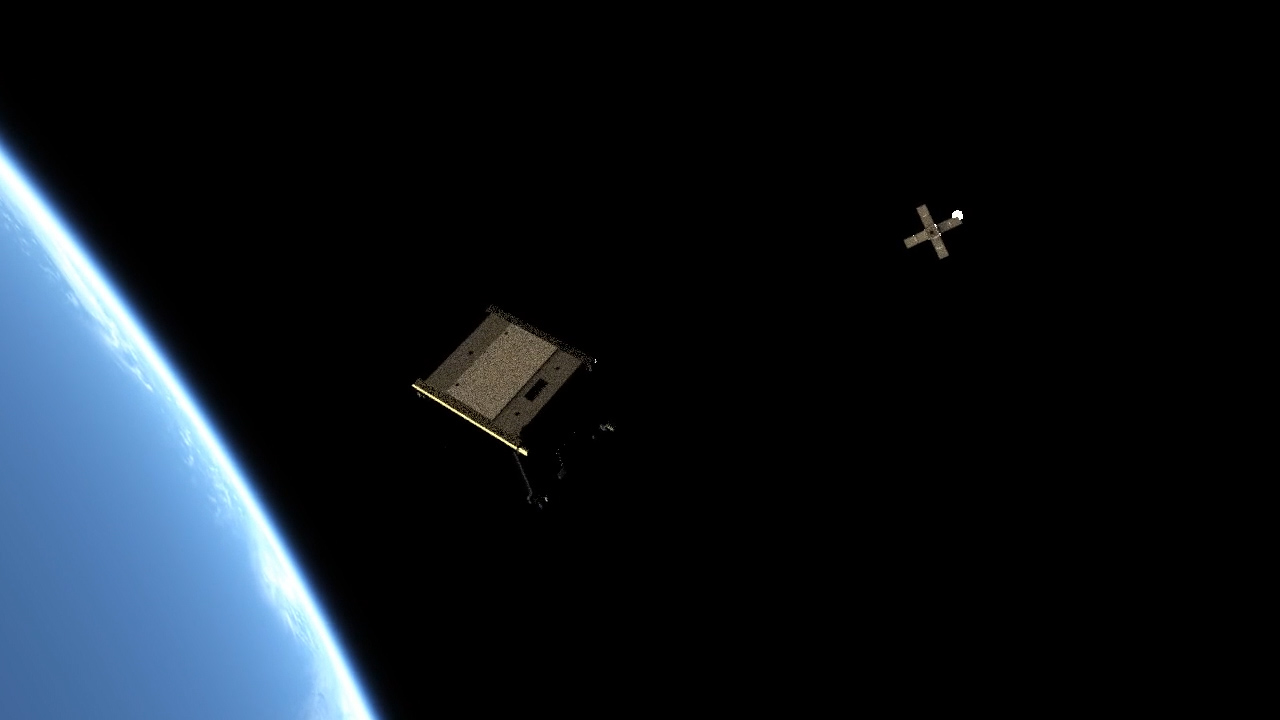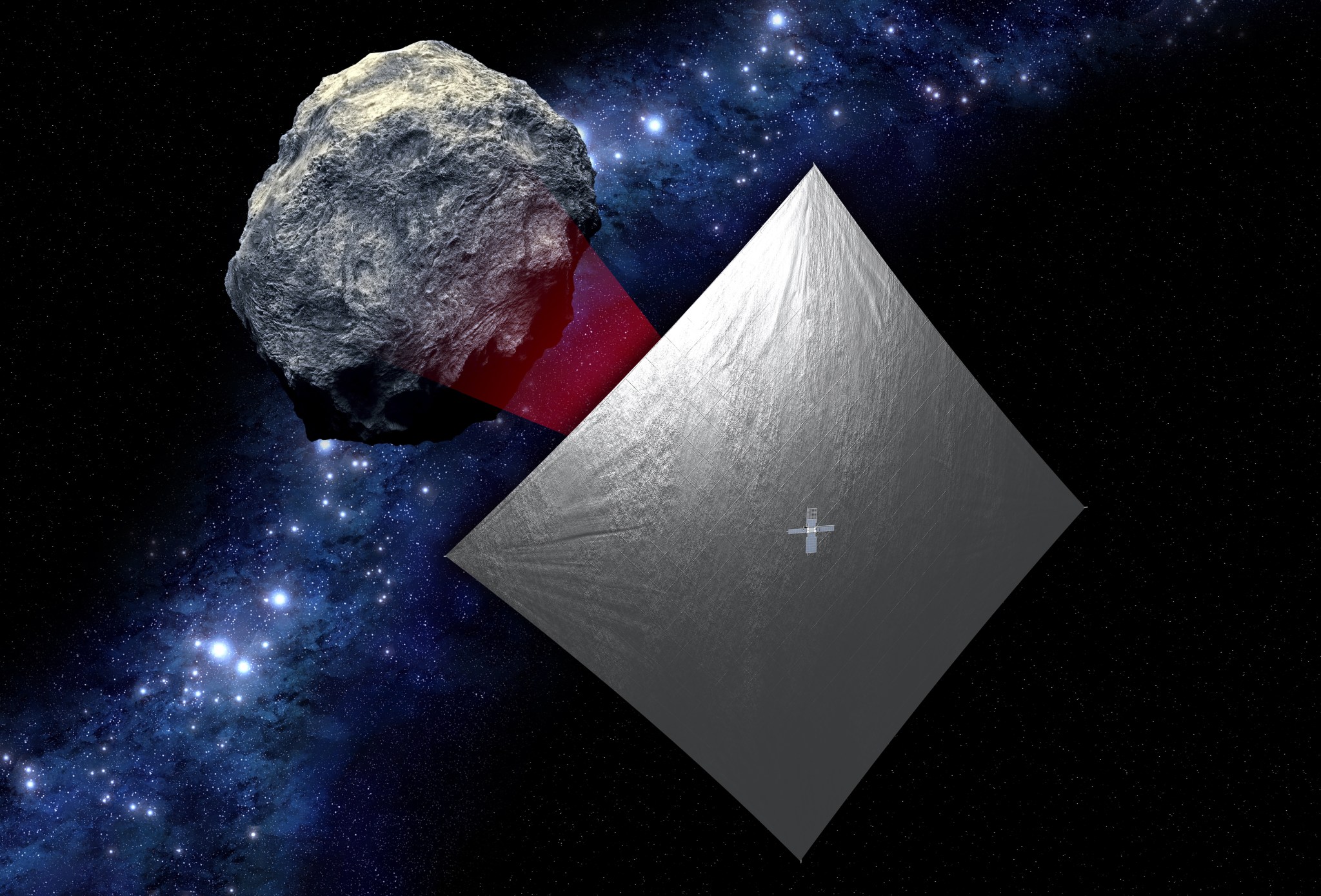In This Week’s Star
- Todd May Named Marshall Space Flight Center Director
- NASA Space Launch System’s First Flight to Send Small Sci-Tech Satellites into Space
- Marshall Honors Fallen Heroes during Day of Remembrance
- All-Hands Meeting with Marshall Center Director Todd May Following NASA Administrator Bolden Address set for Feb. 9
- Top Cube Quest Challenge Entries to Ride with Space Launch System as Secondary Payloads
- NASA Tests Solar Sail Deployment for Asteroid-Surveying CubeSat NEA Scout
- This Week in NASA History: Saturn I S-I Stage Test-Fires at Marshall — Feb. 4, 1961
- Orion and SLS Progress at Michoud Featured on ‘This Week @NASA’
- Obituaries
Todd May Named Marshall Space Flight Center Director
NASA Administrator Charles Bolden has named Todd May director of the Marshall Space Flight Center. May was appointed Marshall deputy director in August 2015 and has been serving as acting director since the Nov. 13, 2015, retirement of Patrick Scheuermann.
As director, May will lead one of NASA’s largest field installations, with almost 6,000 civil service and contractor employees, an annual budget of approximately $2.5 billion and a broad spectrum of human spaceflight, science and technology development missions.
“Todd’s experience and leadership have been invaluable to the agency, especially as we have embarked on designing, building and testing the Space Launch System, a critical part of NASA’s journey to Mars,” said Bolden. “He brings his expert program management and leadership skills and sense of mission to this new role, and I look forward to having him at the helm of Marshall.”
Since its inception in 2011, May led the Space Launch System program through a series of milestones, including a successful in-depth critical design review. SLS, now under development, is the most powerful rocket ever built, able to carry astronauts in NASA’s Orion spacecraft on deep space missions, including to an asteroid and ultimately on a journey to Mars.
May’s NASA career began in 1991 in the Materials and Processes Laboratory at Marshall. He was deputy program manager of the Russian Integration Office in the International Space Station Program at NASA’s Johnson Space Center in 1994. May managed the successful integration, launch and commissioning of the station’s Quest airlock in 1998. He also joined the team that launched the Gravity Probe B mission to test Einstein’s general theory of relativity.
In 2004, May assumed management of the Discovery and New Frontiers Programs, created to explore the solar system with frequent robotic spacecraft missions. He moved to NASA Headquarters in 2007 as a deputy associate administrator in the Science Mission Directorate. Returning to Marshall in June 2008, May was named Marshall’s associate director, technical — a post he held until being named SLS program manager.
May earned a bachelor’s degree in materials engineering from Auburn University in Auburn, Alabama, in 1990. His many awards include NASA’s Exceptional Achievement Medal, the Presidential Rank Award of Meritorious Executive, NASA’s Outstanding Leadership Medal and the John W. Hager Award for professionalism in materials engineering. He has been named a Distinguished Engineer by Auburn. In 2014, he received Aviation Week’s Program Excellence Award, as well as the Rotary National Award for Space Achievement Foundation’s Stellar Award in recognition of the SLS team’s many accomplishments.
A native of Fairhope, Alabama, May and his wife, Kelly, have four children and live in Huntsville.
NASA Space Launch System’s First Flight to Send Small Sci-Tech Satellites into Space
The first flight of NASA’s new rocket, the Space Launch System, will carry 13 CubeSats to test innovative ideas along with an uncrewed Orion spacecraft in 2018.
These small satellite secondary payloads will carry science and technology investigations to help pave the way for future human exploration in deep space, including the journey to Mars. SLS’ first flight, referred to as Exploration Mission-1 (EM-1), provides the rare opportunity for these small experiments to reach deep space destinations, as most launch opportunities for CubeSats are limited to low-Earth orbit.
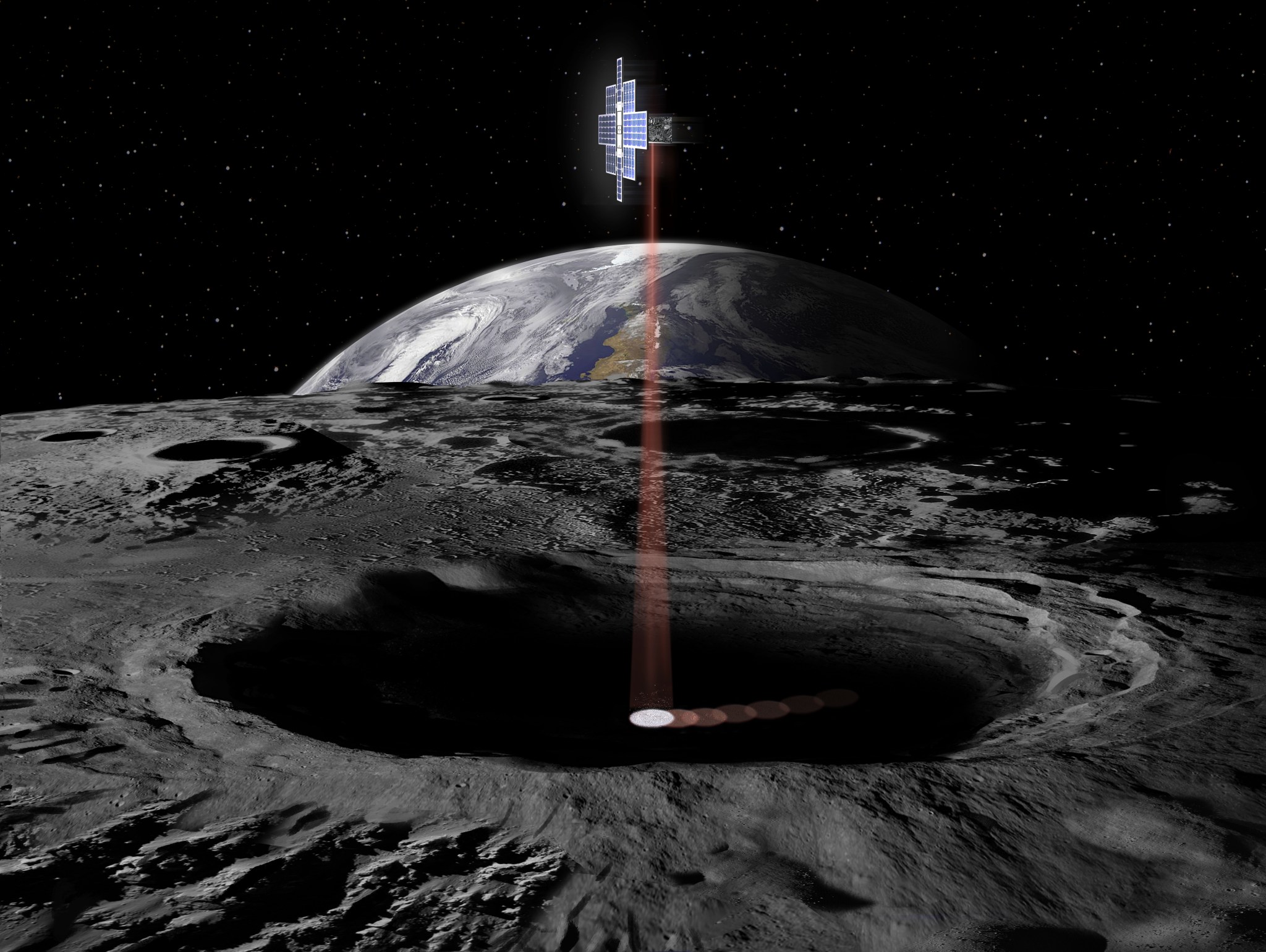
“The 13 CubeSats that will fly to deep space as secondary payloads aboard SLS on EM-1 showcase the intersection of science and technology, and advance our journey to Mars,” said NASA Deputy Administrator Dava Newman.
The secondary payloads were selected through a series of announcements of flight opportunities, a NASA challenge and negotiations with NASA’s international partners.
“The SLS is providing an incredible opportunity to conduct science missions and test key technologies beyond low-Earth orbit,” said Bill Hill, deputy associate administrator for Exploration Systems Development at NASA Headquarters. “This rocket has the unprecedented power to send Orion to deep space plus room to carry 13 small satellites — payloads that will advance our knowledge about deep space with minimal cost.”
NASA selected two payloads through the Next Space Technologies for Exploration Partnerships (NextSTEP) Broad Agency Announcement:
- Skyfire — Lockheed Martin Space Systems Company, Denver, Colorado, will develop a CubeSat to perform a lunar flyby of the moon, taking sensor data during the flyby to enhance our knowledge of the lunar surface.
- Lunar IceCube — Morehead State University, Kentucky, will build a CubeSat to search for water ice and other resources at a low orbit of only 62 miles above the surface of the moon.
Three payloads were selected by NASA’s Human Exploration and Operations Mission Directorate:
- Near-Earth Asteroid Scout, or NEA Scout, will perform reconnaissance of an asteroid, take pictures and observe its position in space.
- BioSentinel will use yeast to detect, measure and compare the impact of deep space radiation on living organisms over long durations in deep space.
- Lunar Flashlight will look for ice deposits and identify locations where resources may be extracted from the lunar surface.
Two payloads were selected by NASA’s Science Mission Directorate:
- CuSP,a “space weather station,” will measure particles and magnetic fields in space, testing practicality for a network of stations to monitor space weather.
- LunaH-Map will map hydrogen within craters and other permanently shadowed regions throughout the moon’s south pole.
Three additional payloads will be determined through NASA’s Cube Quest Challenge — sponsored by NASA’s Space Technology Mission Directorate and designed to foster innovations in small spacecraft propulsion and communications techniques. CubeSat builders will vie for a launch opportunity on SLS’ first flight through a competition that has four rounds, referred to as ground tournaments, leading to the selection in 2017 of the payloads to fly on the mission.
NASA also has reserved three slots for payloads from international partners. Discussions to fly those three payloads are ongoing, and they will be announced at a later time.
On this first flight, SLS will launch the Orion spacecraft to a stable orbit beyond the moon to demonstrate the integrated system performance of Orion and the SLS rocket prior to the first crewed flight. The first configuration of SLS that will fly on EM-1 is referred to as Block I. It will have a minimum 70-metric-ton (77-ton) lift capability and will be powered by twin boosters and four RS-25 engines.
The CubeSats will be deployed following Orion separation from the upper stage. Once Orion is a safe distance away, each payload will be ejected with a spring mechanism from dispensers on the Orion stage adapter. Following deployment, the transmitters on the CubeSats will turn on, and ground stations will listen for their beacons to determine the functionality of these small satellites.
Marshall Honors Fallen Heroes during Day of Remembrance
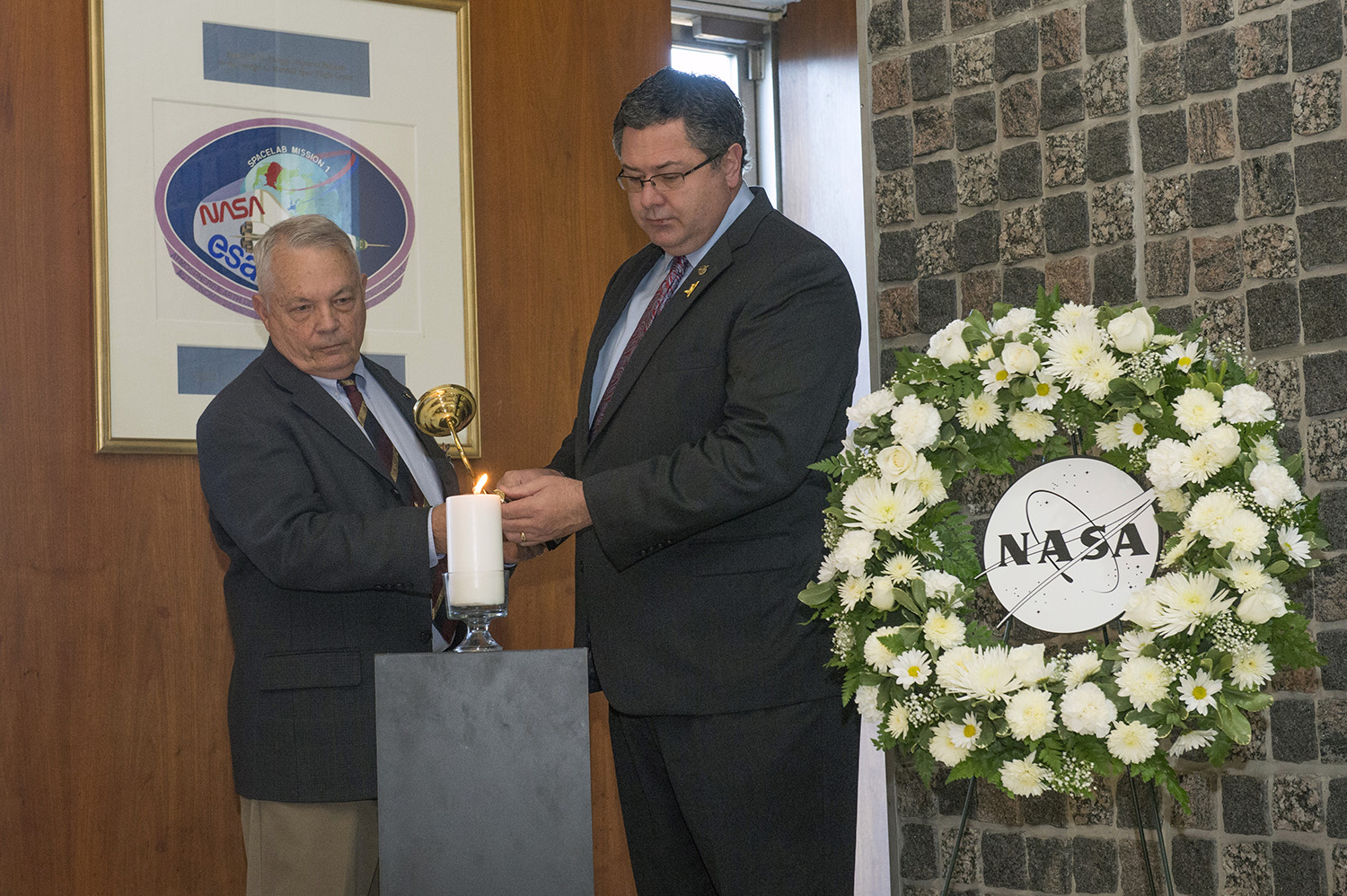
Former NASA astronaut Bob Stewart, left, and NASA Marshall Space Flight Center Acting Director Todd May light a candle to pay tribute to the crews of Apollo 1 and space shuttles Challenger and Columbia, as well as to other NASA colleagues during Marshall’s Day of Remembrance observance Jan. 28 — the 30th anniversary of the Challenger accident. (NASA/MSFC/Emmett Given)
All-Hands Meeting with Marshall Center Director Todd May Following NASA Administrator Bolden Address set for Feb. 9
By Brian C. Massey
NASA’s Marshall Space Flight Center team members are encouraged to attend a viewing of NASA Administrator Charles Bolden’s televised “State of NASA” address at 12:30 p.m. and participate in an all-hands meeting with Marshall Center Director Todd May at 1:15 p.m. Feb. 9 in Morris Auditorium, Building 4200.
Following Bolden’s “State of NASA” address from NASA’s Langley Research Center, May will reflect on Marshall’s achievements in 2015 and look forward to exciting events in 2016 that will advance space science and exploration and enable NASA’s journey to Mars. He also will talk about NASA’s fiscal year 2017 budget proposal and how it affects Marshall.
Marshall team members unable to attend can watch both Bolden’s address and the all-hands meeting live on Marshall Desktop TV. Bolden’s address also will be carried live on NASA TV.
Questions will be taken from the audience at the all-hands and can be submitted anonymously from notecards available at the entrance to Morris Auditorium.
Massey, an ASRC Federal/Analytical Services employee and the Marshall Star editor, supports the Office of Strategic Analysis & Communications.
Top Cube Quest Challenge Entries to Ride with Space Launch System as Secondary Payloads
By Janet Sudnik
Thirteen small satellites will be catching a ride with the Space Launch System and the Orion spacecraft aboard their inaugural flight in 2018, called Exploration Mission-1 (EM-1). A lucky three of them will be earned by the top competitors of NASA’s Centennial Challenges Cube Quest competition.
NASA’s Cube Quest Challenge is designed to foster innovation in small spacecraft propulsion and communications. The competition, offering a total of $5.5 million in prize money, includes three stages: the Ground Tournaments, the Deep Space Derby and the Lunar Derby.
Before the in-space competition, teams first participate in four Ground Tournaments, which are progress checkpoints held every four to six months that include incremental prizes for teams that rate high on mission safety and probability of success. Teams may enter the competition at any of the four tournaments, but must place in the top five in the first or second to be considered for a launch opportunity on EM-1.
“This is an exciting time for teams to launch to the moon and beyond, and the Cube Quest Challenge offers an extraordinary opportunity to test their spacecraft, encouraging the next generation of deep space explorers,” said Jim Cockrell, Cube Quest Challenge administrator at NASA’s Ames Research Center.
Once the spacecraft are deployed from SLS, the Deep Space Derby and the Lunar Derby offer awards for additional achievements in space. Teams not awarded a spot on SLS may still compete in the derbies, but must find an alternative launch vehicle.
The Deep Space Derby will focus on finding innovative solutions to deep space survival and long distance communications using small spacecraft, and the Lunar Derby will focus primarily on propulsion and navigation for small spacecraft while in lunar orbit. Together, these challenges are expected to contribute to opening deep space exploration to non-government spacecraft for the first time.
Sudnik, an ASRC Federal/Analytical Services employee, supports the Office of Strategic Analysis & Communications.
NASA Tests Solar Sail Deployment for Asteroid-Surveying CubeSat NEA Scout
By Brian C. Massey
Progress continues on the journey to Mars as NASA plans to send astronauts deeper into space than ever before, including to an asteroid and ultimately to the surface of Mars. Before humans embark on the journey, the agency will survey an asteroid to learn about the risks and challenges asteroids may pose to future human explorers.
One way NASA will do this is by performing a reconnaissance flyby of an asteroid with Near-Earth Asteroid Scout, or NEA Scout. NEA Scout — a CubeSat, or small satellite — will launch as a secondary payload on the inaugural flight of NASA’s Space Launch System, the world’s most powerful rocket, scheduled to launch in 2018. Information gained from NEA Scout’s flyby will enhance the agency’s understanding of asteroids and their environments and will help reduce risk for future exploration of asteroids and small planetary bodies.
NEA Scout’s second mission objective will be to develop and verify a low-cost reconnaissance platform capable of carrying a wide range of research spacecraft to many destinations. To do this, NEA Scout will use a solar sail, harnessing solar pressure to propel the spacecraft.
NEA Scout’s flight solar sail — which will be larger and travel farther than any NASA has ever deployed in space — will be 86 square meters, approximately the length of a full-size school bus. Engineers at NASA’s Marshall Space Flight Center recently conducted a series of tests with a sail roughly half that size — 36 square meters — to verify the folding and deployment of the sail in deep space.
“We were able to zero in some specifics of design, motor size, hardware attrition and even the time required to fold and deploy the sail,” said Tiffany Russell Lockett, NEA Scout Sail systems engineer at Marshall. Next spring, the team will build and test a full-size engineering development unit.
Only one-third of NEA Scout’s total size can be dedicated to the solar sail. Each of the 13 CubeSats hitching a ride on the SLS will be the size of a large shoebox and weigh less than 30 pounds. For the school bus-size sail to fit within the small space requirements, it will have to be meticulously folded and then unpacked in space.
To test the folding and deployment process, engineers built a low-cost test article using parts from previous programs. The lightweight assembly consists of three 3D-printed spools — an oblong spool that contains the sail’s material and two smaller spools, each containing two booms, or the sail’s arms. The booms — which will unfold the sail and hold it in place during flight — are strong, yet flexible.
“The booms — much like a handyman’s metal tape measure — are very strong when held out straight, and when bent they become flexible enough to be wound around the spools — saving space,” said McNutt.
The sail’s material is as thin as a human hair and has to be meticulously folded and wrapped around the oblong spool. Once in space, the booms — each attached to a different corner of the sail — will extend, unpacking the solar sail.
“We successfully tested a new folding technique that has never been used before with solar sails,” said McNutt. “The sail material is folded like an accordion and unreels like a bow tie as the booms deploy.”
McNutt believes solar sails like NEA Scout’s could be a game changer in the future of deep-space missions. “In the past, they have been relatively small,” she said. “Advances like NEA Scout’s sail could enable larger and larger spacecraft. The larger the spacecraft, the larger the solar sail will need to be. You have to work your way up — this is a step in the direction of bigger and better.”
NASA’s Advanced Exploration Systems manages NEA Scout with the team led at Marshall with support from the Jet Propulsion Laboratory. AES infuses new technologies developed by NASA’s Space Technology Mission Directorate and partners with the Science Mission Directorate to address the unknowns and mitigate risks for crews and systems during future human exploration missions.
Massey, an ASRC Federal/Analytical Services employee and the Marshall Star editor, supports the Office of Strategic Analysis & Communications.
This Week in NASA History: Saturn I S-I Stage Test-Fires at Marshall — Feb. 4, 1961
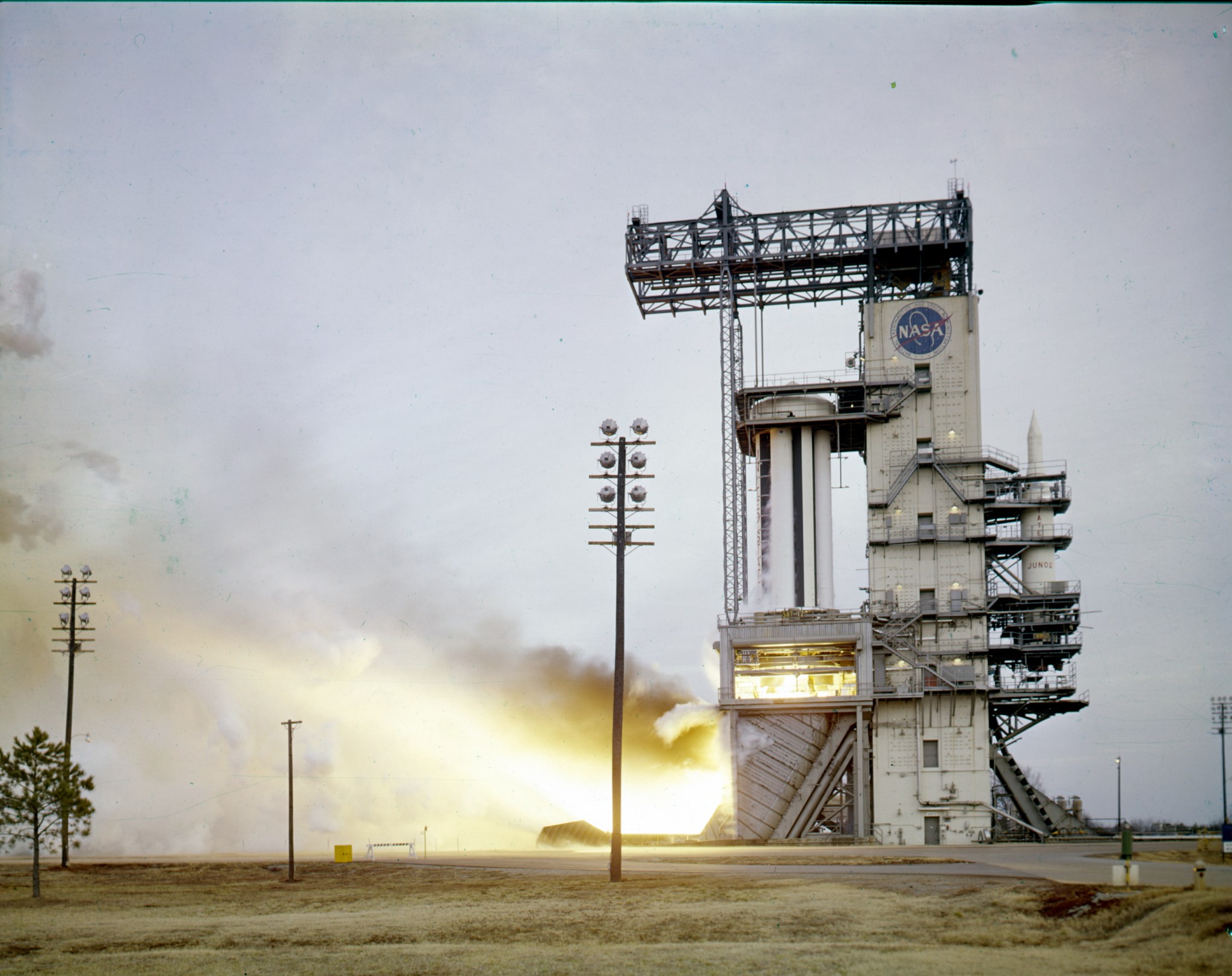
This week in 1961, the Saturn I S-I stage equipped with eight H-1 engines successfully test-fired at NASA’s Marshall Space Flight Center. The Saturn project was formally approved in January 1960, and Saturn I booster tests, which verified the clustered-booster concept, began in June 1960. The NASA History Program documents and preserves NASA’s remarkable history through a variety of products — photos, press kits, press releases, mission transcripts and administrators’ speeches. For more pictures like this one and to connect to NASA’s history, visit the History Program’s Web page. (NASA/MSFC)
Orion and SLS Progress at Michoud Featured on ‘This Week @NASA’
Completion of the Orion Pressure Vessel and progress of NASA’s Space Launch System rocket are featured in the latest edition of “This Week @NASA,” a weekly video program broadcast nationwide on NASA-TV and posted online.
A Jan. 26 event was held at NASA’s Michoud Assembly Facility marking the completion of welding for the next Orion deep-space crew module’s pressure vessel. The event allowed NASA officials an opportunity to thank employees for all their hard work, as well as show progress of Orion and the core stage of the SLS, the most powerful rocket NASA has ever built.
The Orion pressure vessel was shipped to NASA’s Kennedy Space Center this week, where engineers will continue to prepare it for flight on SLS during the Exploration Mission-1, currently scheduled for late 2018. That uncrewed flight — the maiden voyage for SLS — will take the Orion capsule thousands of miles beyond the moon during a three-week mission.
SLS is being built at NASA’s Marshall Space Flight Center and remains on track for launch capability readiness. Marshall manages both Michoud and the SLS program.
View this and previous episodes at “This Week @NASA” or at https://www.youtube.com/user/NASAtelevision.
Obituaries
Jerry L. Johnson, 83, of Okmulgee, Oklahoma, died Jan. 26. He retired from the Marshall Center in 1981 as an aerospace engineer. He is survived by his wife, Barbara Johnson.
Frank P. Lively, 93, of Birmingham, Alabama, died Jan. 27. He retired from the Marshall Center in 1987 as a business specialist.
Kenneth D. Sowell, 77, of Huntsville died Jan. 29. He retired from the Marshall Center in 1994 as a contract specialist. He is survived by his wife, Barbara Sowell.




























